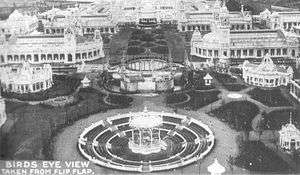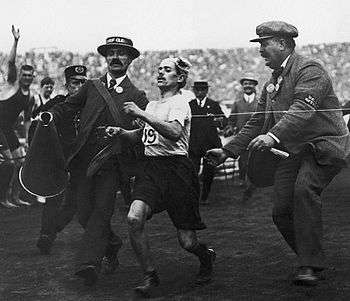White City, London
| White City | |
 White City |
|
| Population | 13,389 (2011 Census. Wormholt and White City Ward)[1] |
|---|---|
| OS grid reference | TQ233807 |
| London borough | Hammersmith & Fulham |
| Ceremonial county | Greater London |
| Region | London |
| Country | England |
| Sovereign state | United Kingdom |
| Post town | LONDON |
| Postcode district | W12 |
| Dialling code | 020 |
| Police | Metropolitan |
| Fire | London |
| Ambulance | London |
| EU Parliament | London |
| UK Parliament | Hammersmith |
| London Assembly | West Central |
Coordinates: 51°30′45″N 0°13′39″W / 51.5126°N 0.2275°W
White City is a district in the London Borough of Hammersmith and Fulham and forms the northern part of Shepherd's Bush. Today, White City is home to the BBC Television Centre and BBC White City, and Loftus Road stadium, the home of football club, Queens Park Rangers FC.
History
The area now called White City was level arable farmfields until 1908, when it was used as the site of the Franco-British Exhibition and the 1908 Summer Olympics. In 1909 the exhibition site hosted the Imperial International Exhibition and in 1910, the Japan-British Exhibition. The final two exhibitions to be held there were the Latin-British Exhibition (1912) and the Anglo-American Exhibition (1914), which was brought to a premature end by the outbreak of the First World War.[2] During this period it was known as the Great White City due to the white marble cladding used on the exhibition pavilions, and hence gave its name to this part of Shepherd's Bush.
The White City Stadium in the north of the area, known as the Great Stadium and seating 66000, was officially opened by King Edward VII on 27 April 1908 for the Olympics. After the Olympics, it continued to be used for athletics until 1914, and was later turned into a greyhound racing track, although it was also used for short periods by Queens Park Rangers football club, and for other sports. In 1931, a 440yd running track was installed for the Amateur Athletic Association Championships, held there from 1932 to 1970. It hosted one match during the 1966 World Cup. The stadium was demolished in 1985 to make way for the BBC White City building. Today, the 1908 Olympics are commemorated with a list of athletes inscribed on the side of the BBC Broadcast Centre Building, and the athletics finish line is marked in the paving outside the building.
The Marathon from these London Olympics played an important part in the development of the modern marathon race. In the early years of competitive international sport, the long distance marathon race did not have a standard set distance. The distance run at the first seven Olympics from 1896 to 1920 varied between 40km and 42.75 km. The starting point of the race at the 1908 Olympics was at Windsor Castle creating a distance of 26 miles 385 yards (42.195 km) to the finishing line at White City stadium. In 1921 this was adopted as the standard distance.
To house the growing population of Shepherd's Bush, a five-storey housing estate was built in the late 1930s, which also took the name of the White City. Streets were named after countries that had featured in the exhibitions.
In 2001, BBC Television Centre was damaged by a car bomb attack by the Real IRA. The bomb went off on Wood Lane, in front of the Television Centre news building.[3]
On 30 October 2008, Westfield shopping centre was opened.[4]
 Bird's eye view of part of the Franco-British Exhibition (1908)
Bird's eye view of part of the Franco-British Exhibition (1908) The White City Stadium in 1908
The White City Stadium in 1908

| Wikimedia Commons has media related to 1908 Summer Olympics. |
21st century redevelopments
Westfield Group (with Hausinvest Europa) has built a new shopping centre, bounded by the West Cross Route (A3220, formerly the M41 motorway), the Westway (A40) and Wood Lane (A219). This centre has been branded "Westfield London".
Two stations were built to serve the centre close to the sites of closed former London Underground stations:
- Wood Lane on the Hammersmith & City line, located to provide a walking distance connection with the Central line station at White City.
- Shepherd's Bush on the West London Line, to the east of the site adjacent to the Holland Park roundabout and served by London Overground trains.
In 2007, it was announced that the BBC would sell its landmark Television Centre as part of a cost-cutting programme.[5]
In 2008 English Heritage announced its recommendation to list parts of TV centre[6] as an excellent example of 20th-century architecture.
Following the sale of the Television Centre, White City has become a key regeneration area within Central London. A strong partnership between White City Living by St James, Westfield London, Stanhope and Imperial College London, has created a vision for the future of White City area. The regeneration project will deliver 5000+ high quality new homes, 2 million sq ft of commercial office space, 30 acres of public space, 19,000 jobs and Westfield London will become the largest shopping centre in Western Europe, with over 400 stores, multiple cinema screens, restaurants, bars and cafes.
Education

Imperial College London purchased the BBC Woodlands site for 28 million pounds in 2009 and was demolished the following year. Imperial College is currently developing a seven-acre campus on the site (Imperial West).
Schools in the area include Ark Burlington Danes Academy and Phoenix High School.
Nearest places
- Wormwood Scrubs
- Notting Hill
- Kensal Green
- Bayswater
- Harlesden
- North Kensington
- Acton
- West Kensington
- Shepherd's Bush
Nearest tube stations
Nearest railway stations
Popular culture
Pete Townshend, of The Who and former resident of Shepherd's Bush, released a solo album entitled White City: A Novel in November 1985 on Atco. The title refers to a story which accompanies the album and which takes place in the London area of White City.
The Pogues made a song about the stadium and its demolition, called "White City". It can be found on their 1989 album Peace and Love.
North of the Westfield shopping centre itself, the grade II listed Dimco Buildings (1898), now refurbished as a bus depot[7][8] were used as the location for the ‘Acme Factory’ in the 1988 film Who Framed Roger Rabbit?.[9]
The journalist Daisy Waugh lives in White City.[10]
See also
Gallery
- BBC Television Centre.
 Proposals for Shepherd's Bush tube station; now open.
Proposals for Shepherd's Bush tube station; now open. The BBC Media Village, on the site of the Olympic Stadium (visible in the Background of BBC 1 prime time show "The One Show").
The BBC Media Village, on the site of the Olympic Stadium (visible in the Background of BBC 1 prime time show "The One Show"). BBC TV centre, seen from Shepherd's Bush H&C tube station.
BBC TV centre, seen from Shepherd's Bush H&C tube station. White city tube station.
White city tube station.
References
- ↑ "Hammersmith and Fulham ward population 2011". Neighbourhood Statistics. Office for National Statistics. Retrieved 15 October 2016.
- ↑ "White City Community Centre display".
- ↑ "Bomb blast outside BBC". BBC News. 4 March 2001. Retrieved 27 December 2009.
- ↑ "Enormous shopping complex opens". BBC News. 30 October 2008. Retrieved 27 December 2009.
- ↑ Midgley, Neil; &, Tv; Clout, Laura (15 October 2007). "BBC television centre may be sold for £300m". London: Daily Telegraph. Retrieved 2 November 2007.
- ↑ ""Auntie" honoured in recommendation to list parts of BBC television centre". English heritage. 15 October 2007. Retrieved 1 July 2008.
- ↑ London Borough of Hammersmith and Fulham. "Bus Station Boost". Retrieved 27 December 2009.
- ↑ Yasmine Estaphanos. "A Piece of White City History is Brought Back to Life". Retrieved 27 December 2009.
- ↑ The Worldwide Guide to Movie Locations. "Who Framed Roger Rabbit filming locations". Retrieved 2 October 2007.
- ↑ Debrett's Peerage & Baronetage 2008, p. 1094
External links
- Official Site of White City Development
- Cllr. Stephen Cowan (Lab) – Leader of the Opposition
- Local Labour Party
- Details of new transport infrastructure
- White City development from local youth group
